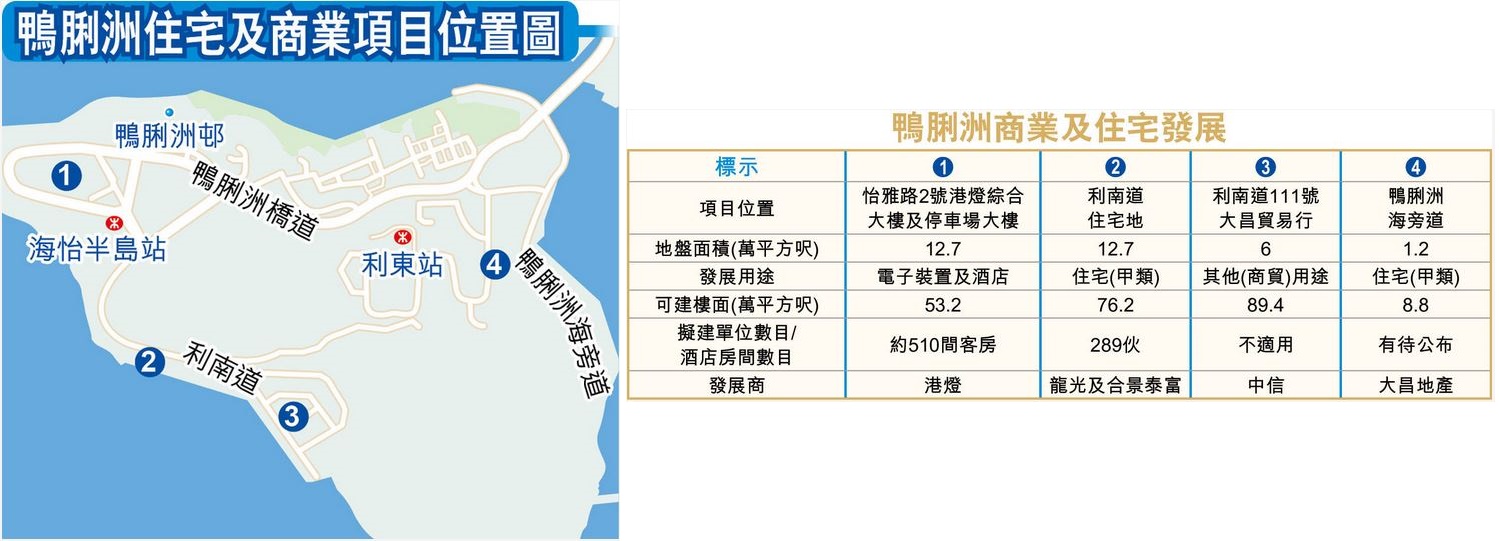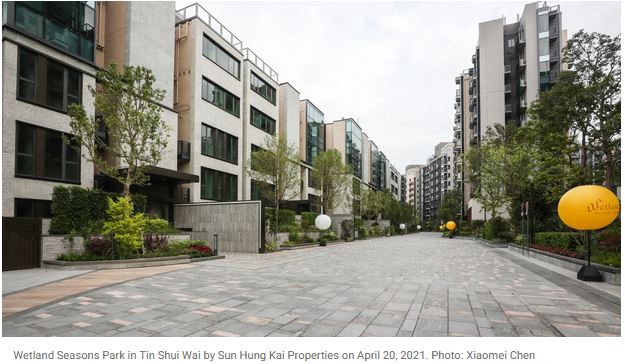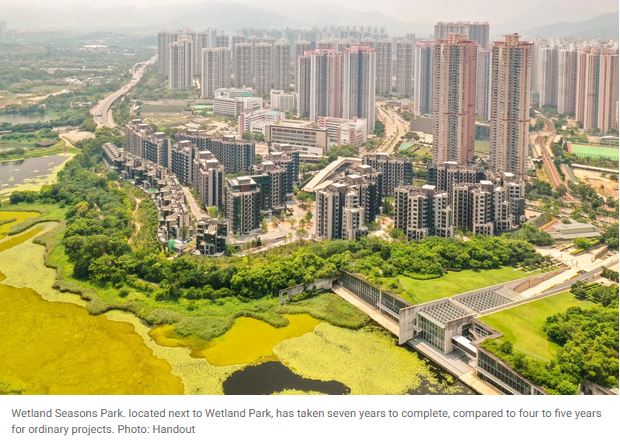新地 (00016) 成功击退9组财团,以86.14亿元高价夺古洞发展区首幅住宅用地,每平方呎楼面地价约7,184元,远高于市场估值上限44%,亦较邻地补地价倍升,新地看好区内发展,预计总投资额约180亿元,料日后落成呎价达1.8万元。
高估值上限44% 料日后卖1.8万元呎
规划多年的新界东北,发展进程渐见眉目,地政总署昨日公布,古洞第25区地皮由新地以86.14亿元投得,每平方呎楼面地价约7,184元。较市场估值上限约60亿元,高约44%。倘扣除公共交通交滙处6.78万平方呎楼面,楼面地价达7,614元。
而相较于2013年11月批出的上水官地 (现时为恒地 (00012) 旗下高尔夫‧御苑) 的每平方呎楼面地价约5,200元,高出约38%。倘与比邻第24区恒地持有的用地相比,3年前补地价金额约12.4亿元,每平方呎楼面补地价约3,643元,是次新地投得25区用地倍升。
雷霆:总投资额约180亿
新地副董事总经理雷霆表示,集团很高兴投得古洞地皮,地皮将来是双铁路交滙站,位置十分优越,而且未来区内亦有足够生活及就业配套。集团将会在项目兴建中小型单位,预计总投资额约180亿元。
对于是次发展商以高价夺得古洞地,莱坊执行董事林浩文认为,是次中标价对日后推出的古洞地皮具指标性作用,与当年啟德发展区情况类似,即市场原本不算太看好该区地价,惟该区首幅地皮批出后,区内往后地皮的中标价随即跟随调高。他亦预计,发展商日后会以同系类似元朗YOHO Town的模式发展,落成后呎价料由1.8万元起。现时同区粉岭及上水一带的二手屋苑,平均成交呎价约1.4万至1.5万元,若按落成后每呎售价约1.8万元计,可见日后项目呎价较同区二手高。
测量师纷调高已纳入本年度卖地计划的同区两幅用地,其中古洞第24区,可建楼面面积约492,390平方呎,估值由原先22.1亿元至24.6亿元,调升至29.5亿元至36.9亿元;而粉岭公路与青山公路交界--古洞段用地,可建楼面面积约71,108平方呎,则由原先3.9亿至5亿元,调升至4.84亿至5.26亿元。
新地在区内拥有不少发展项目,其中新地就古洞双鱼河东岸的地皮,于2019年向城规会修订申请,并计划在项目兴建37幢不高于3层的洋房,涉及住宅楼面面积约8.48万平方呎,料日后区内项目可产生协同效应。
上述地皮位于古洞第25区,即怡景花园及前石仔岭安老院的位置,邻近规划中的北环綫古洞站,可作住宅发展,地盘面积约19.99万平方呎,以地积比率约6倍计,可建楼面约119.9万平方呎。按照卖地条件,发展商需兴建公共运输交滙处,涉及楼面面积不少于6.78万平方呎。而项目亦需于2028年12月31日前竣工。
地皮于上周五截标,共10份标书,早前测量师估值介乎48亿至60亿元,每平方呎楼面地价约4,000至5,000元。
(经济日报)
发展商增土储 新发展区成焦点
由于港九市区的大型地皮的供应所剩无几,新界北将会成为未来住宅供应重镇之一,再加上政府近年加大力度提供公营房屋供应,私人发展商为维持土地储备,这类位于新发展区的大型土地变成发展商的兵家必争之地。
市区大型住宅供应 所剩无几
政府近年调整公私营房屋的比例,私楼未来供应会愈来愈紧张,而现时市区的大型住宅供应已经所剩无几,港岛黄竹坑站及将军澳日出康城上盖早前已批出所有期数的发展权。至于啟德新发展区,现时卖地表上亦再未有住宅地,政府在早前的《财政预算案》上表示,啟德未来会有5幅商业地改划作住宅,提供约5,800个单位,但整体而言,市区未来可见大型住宅地皮的供应寥寥可数。
看好发展潜力 率先高价投地
而未来住宅供应重镇将会集中在东涌、新界西北以及明日大屿的人工岛。而明日大屿发展年期最长,发展商更加把握机会竞投新发展区的土地作发展。根据政府现时的规划,用地附近将会有未来拟建的北环綫古洞站,现时预计最快2027年才通车,新地 (00016) 今次明显看好区内日后的发展潜力,率先出高价投地。
而事实上,过往新地在新界区亦有不少类似的大型住宅发展经验,例如元朗YOHO、天水围Wetland系列楼盘,整体的销情口碑相当不俗,相信新地亦会借镜这些楼盘的经验作发展。
(经济日报)
鸭脷洲加快转型 发展住宅商业项目
近年鸭脷洲发展加快,当中西南面利南道的工业区正转型成为住宅及商业发展,包括中信持有的利南道111号大昌贸易行工业项目申请改作住宅发展。
中信大昌贸易行 拟改划住宅
鸭脷洲区内发展以住宅为主,受惠港铁南港岛綫通车,区内住宅及商业发展均有所加快,区内有多个大型的公私营住宅项目,现时区内的工业发展分散在东面的海旁道船厂,以及西南面利南道的工业区。当中位于鸭脷洲西南面的利南道工业区,获规划署改划成「其他指定商贸」用途,而西面利南道地皮原作为货物装卸区等工业用途,则获改划转型作为住宅及休憩用地。
而位于利南道商贸区的中信利南道111号大昌贸易行工业项目,于2015年已获批可建22层高商厦,涉及商用楼面约89.4万平方呎,惟近年有见利南道住宅地高价批出,发展商亦有意将地皮改划为住宅发展,拟提供448个中大型单位,住宅楼面涉约32.8万平方呎,并提供小量零售食肆楼面。
事实上,邻近的利荣街2号新海怡广场,原为楼高24层的工厦物业,业主华厦置业 (00278) 早在2010年已经全幢改装作商业用途,现时成为名牌特卖场及傢俬设计公司,属区内首个成功转型的项目,总楼面约46万平方呎。
利南道豪宅 可供约289伙
另外,邻近前身为香港驾驶学院租借的利南道住宅地,则在2017年由龙光地产及合景泰富 (01813) 以约168.6亿元投得,发展商将该地计划打造成顶级豪宅项目,提供约289个住宅单位,估计平均每户面积超过2,000平方呎。
鸭脷洲岛上最大的私人屋苑海怡半岛,前身亦是港灯的发电厂,目前在区内怡雅路2号,港灯仍然持有综合大楼及停车场项目,于2018年2月以约6.6亿元完成补地价,将与长实 (01113) 合作发展,计划兴建为17层高酒店,可建楼面约38.1万平方呎,预计将提供约510个酒店客房。至于综合大楼部分则会保留,总项目楼面共约53万平方呎。

(经济日报)
便利店低逾6成 25万租海防道铺
零售高峰期后 近10年首录进驻个案
铺租回落,民生商户进驻核心区一綫街。海防道地下一铺位,以每月约25万租出,新租客为7-11便利店,较旧租低约65%,属近地段近10年首录便利店租地铺个案。
尖沙咀海防道地下铺位,获便利店租用,涉及地段47号地下,面积约550平方呎,获7-11便利店租用,现正进行装修。
翻查资料,该物业曾由连锁鞋店Crocs于2011年以每月71万元租用,当时正值零售高峰期,租金处高位。品牌租用多年后,直至2019年迁出,业主曾把地下短租予手机配件店及利市封店。
去年中,铺位由中药品维特健灵以每月约25万租用,租期1年,其后品牌转租同地段一个面积约400平方呎,月租约20餘万元。如今铺位再租予7-11,租金较高峰期跌65%。
事实上,过往尖沙咀海防道有便利店租户,早年租用汉口道及海防道交界铺位,为2011年后进入零售高峰期,各大品牌抢铺,租金倍升,便利店亦绝迹海防道,故是次属近10年地段首录便利店租务。
葵涌餐厅铺 42年升值71倍
代理透露,中环些利街18号地下,建筑面积为3,050平方呎,刚由日本餐厅承租,每月租金18.2万元,呎租约60元,较旧租下调约45%。
另消息称,葵涌盛芳街23至39号地下,面积约850平方呎,以约6,200万元成交,铺位由餐厅以每月约18万元租用,回报率约3.5厘。原业主1979年以86万买入,持货42年,铺位升71倍。
代理表示,随着零售消费展现增长,气氛好转加上租金经已回落,商铺租赁亦转趋活跃。一綫街铺租金在本年首季按季跌幅介乎4至6.2%,由高峰水平回落约74至81%,该行预计,随着社交距离措施有望逐渐放宽,预料餐饮扩充趋势在短期内将会持续。
(经济日报)
核心区铺租按季跌逾4% 代理:租金回落有助食肆扩张
随着零售消费增长,加上租金高位回落,商铺租赁趋活跃。代理指出,一綫街铺租首季按季跌幅介乎4%至6.2%,主力于民生消费商户,趁机进驻以往难以负担的核心区铺,食肆扩充主导租赁市场。
代理表示,今年首两个月零售销货额回升,按年升幅达2.7%,为自2018年第一季以来首录升幅,有见经济露曙光,加上租金已回落,一綫街铺租由2013年高位回落约69%至81%,今年首季按季再跌介乎4%至6.2%,民生消费商户趁机进驻以往难以承租的核心区,包括时装品牌American Eagle租下中环陆海通大厦一个约7400方呎铺位。
铺租较高位回落逾69%
铺租回落,有助食肆扩充,他表示,自2017年起,儘管经历贸易战、反修例事件及疫市,截至去年底共25329个食肆牌照获批,按年升4.6%。而该行自2020年以来促成65食肆租赁,半数位于非核心零售区,近半位于将军澳、荃湾及东涌区,人口增加及家庭收入增长中的地区,最受食肆垂青。
过去一年促成65宗食肆租赁
代理续说,今年首两月整体零售销售增长,耐用消费品销售额在2019年及2020年,分别录11.8%及24.4%按年跌幅,本年首两月按年升28.1%;服装及鞋类销售额在连跌8个季度后 (其中6季跌幅逾20%),本年首两月按年升7.5%。民生消费成为救市主力,全因市场仍然缺乏游客,据香港旅游发展局数字,本年首两月内地访港旅客合计共有6679人,按年大跌99.7%。
(星岛日报)
Sales details of new Kai Tak project released
Henderson Land Development (0012) uploaded the sales brochure of The Henley I in Kai Tak, covering 479 units with sizes ranging from 186 square feet to 1,350 sq ft.
The smallest flats coming with a 95-97-sq-ft garden are Flat G on the ground floor of Block A to D.
The project is expected to be completed on April 30, 2022.
Meanwhile, Sun Hung Kai Properties (0016) will put 82 units at Regency Bay II in Tuen Mun on sale on Saturday. The flats range from 299 sq ft to 501 sq ft with a selling price between HK$17,192 and HK$20,310 per sq ft after discounts. The cheapest flat is HK$5.68 million.
Still in the primary market, Road King Infrastructure (1098) will open sales of 240 units at SouthLand, above Wong Chuk Hang Station, on Saturday. Ten four-bedroom units will be launched by tender.
Sino Land (0083), meanwhile, has released the third price list of 67 units at One Soho in Mong Kok, with an average selling price of HK$24,918 per sq ft after discounts. The developer received 650 checks for One Soho, and sales of 168 units will be launched on Saturday.
And mainland developer Sino-Ocean Group (3377) opened the show flat of Uptify in Mong Kok yesterday and the price list of the first batch of 30 units will be released today.
Among other transactions, six flats at St Michel in Sha Tin were sold by tender, with a 1,502-sq-ft unit sold for HK$30.05 million, the highest in the project.
(The Standard)
Sun Hung Kai and think tank call for the increase of plot ratio in wetland buffer to increase land supply for affordable homes
Building density in the Wetland Buffer Zone could be higher to accommodate medium-height apartment buildings, said SHKP’s planning director
The Our Hong Kong Foundation also supports a review of the planning regulations for the city’s wetlands, as they were first drafted in 1997
Hong Kong’s largest developer by capitalisation and a prominent think tank are urging the local government to allow areas with low ecological value within the city’s wetlands buffer area to be developed into higher-density housing projects to alleviate housing shortage.
Building density in the Wetland Buffer Zone, a strip of land measuring about 1,200 hectares (2,965 acres) about 500 metres away from the Deep Bay Wetland Conservation Area in the northwestern corner of Hong Kong’s New Territories near the border with Shenzhen, could be higher to accommodate medium-height apartments of about 15 stories, said Sun Hung Kai Properties (SHKP)’s planning and development project director Spencer Lu.
The current plot ratio – the total built-up area of a development divided by the total site area – in the buffer zone is between 0.2 and 0.4 times, which limits the versatility of the land in the area, forcing developers to build million-dollar villas such as the Palm Springs development to remain profitable.
“Development versus conservation is not a zero-sum game,” said Robert Chan, executive director of Sun Hung Kai Real Estate Agency, a unit of the developer, citing the firm’s latest housing project in the buffer area of Tin Shui Wai as the benchmark of property development integrated in nature conservation.

The developer already has three residential projects in the buffer area, including the 1,727 apartments at the Wetland Seasons Park in Tin Shui Wai with a plot area of between 1.39 times and 2.15 times. The second, adjacent project under construction at Tin Shui Wai Lot 33 comprises 1,765 flats, 260 villas and six houses, while the third project at Tung Shing Lei in Yuen Long offers 1,518 apartments.
The urging underscores the long-standing debate between property development and conservation in the world’s least affordable housing market for nine successive years in 2019, where a shortage of usable land has been blamed as the driving force for the almost sixfold jump in average home prices over 16 years. The call for turning the Wetland Buffer Area into housing has also been supported by the Our Hong Kong Foundation, a think tank headed by the city’s first Chief Executive Tung Chee-hwa, which said that higher density for development could be an answer for housing shortage and help to contain the runaway home prices.
“The government should review the planning as there has been lots of changes in the last two decades” since the plot ratio regulations were drafted in 1997, said the foundation’s senior researcher Ryan Ip.
The Deep Bay Wetland Conservation Area abuts the Shenzhen Bay, which separates Hong Kong from Shenzhen. The Mai Po nature reserve and Hong Kong Wetlands Park are located in this area. All but 5 per cent of the 1,200 hectares in the buffer zone have either been developed into housing, or are earmarked as brownfield sites, or are sitting vacant, with a tiny portion being used as fish ponds, said Lu. Any plan to develop in the buffer area requires an ecological impact assessment (EIA) study to be approved before construction can commence.
SHKP’s Wetland Seasons Park, located just next to the city’s wetlands, is being offered as an example of development integrated into conservation, Chan said.

The 20 apartment buildings in the project are each limited to 10 stories in height. Up to 35 per cent of the site is reserved for landscaping, involving the planting of 1,300 trees of 48 different species and 150,000 shrubs of 200 species. The developer erected a six-metre noise barrier and halted construction for six months during winter to avoid disturbing the flocks of herons, egrets and migratory birds nesting in the park.
“The project took about seven years to complete, compared with four to five years for ordinary residential developments,” Chan said. “Construction cost was about 10 per cent higher than normal developments, but it was worth it.”
SHKP sold 1,670 apartments at Wetland Seasons Park alone as of December, for a total sales revenue of nearly HK$11 billion (US$1.42 billion), compared with the HK$2 billion it paid the government in 2014 for buying the land at Tin Shui Wai, according to data by Dataelements. The project at Lot 33 has not been released for sale.
The momentum is moving in the developers’ direction. More than 40 per cent of the buffer zone, or about 513 hectares, fall within the land-use zone that allow residential development to be erected, Hong Kong’s Secretary for Development Michael Wong said last month in the city’s legislature. The government would review the planning guidelines related to the buffer area “on the premise of balancing the needs for conservation and increase of housing land supply,” he said.
MTR Corporation, the city’s subway operator and a major land owner, has obtained the go-ahead to proceed with its development and design of the Northern Link, with three proposed stations at Ngau Tam Mei, San Tin and Kwu Tung close to the buffer area.
Still, the higher density with the proposed Northern Link could pose potential threat to the fragile ecology of the buffer area, said Roy Ng Hei-man, campaign manager for the Conservancy Association, Hong Kong’s largest environmental advocacy group.
“The purpose of the Wetland Buffer Area is to safeguard the core reserve area,” Ng said. “We are worried about the multiple impact on the conservation area as more property and infrastructure developments arise in the sensitive area. More importantly, the impact may not be seen until many years from now.”
(South China Morning Post)